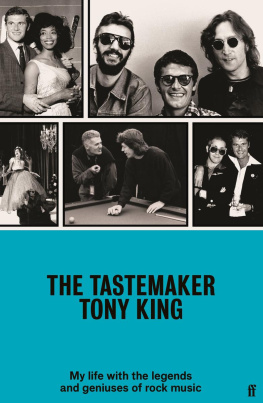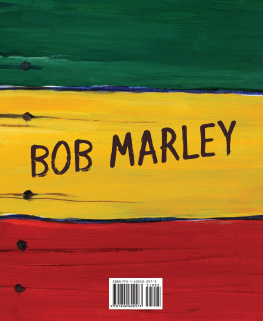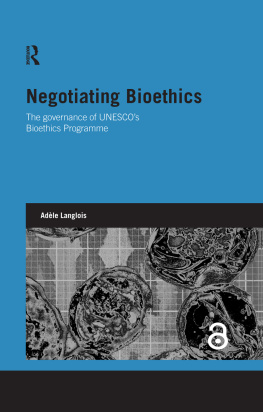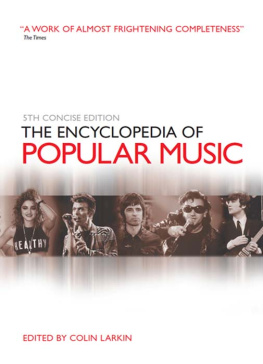First published 2011 by Ashgate Publishing
Published 2016 by Routledge
2 Park Square, Milton Park, Abingdon, Oxon 0X14 4RN
711 Third Avenue, New York, NY 10017, USA
Routledge is an imprint of the Taylor & Francis Group, an informa business
Copyright 2011 Tony Langlois. For copyright of individual articles please refer to the Acknowledgements.
All rights reserved. No part of this book may be reprinted or reproduced or utilised in any form or by any electronic, mechanical, or other means, now known or hereafter invented, including photocopying and recording, or in any information storage or retrieval system, without permission in writing from the publishers.
Notice:
Product or corporate names may be trademarks or registered trademarks, and are used only for identification and explanation without intent to infringe.
Wherever possible, these reprints are made from a copy of the original printing, but these can themselves be of very variable quality. Whilst the publisher has made every effort to ensure the quality of the reprint, some variability may inevitably remain.
British Library Cataloguing in Publication Data
Non-Western popular music. (The library of essays on popular music)
1. Popular music-Asia-History and criticism. 2. Popular music-Africa-History and criticism.
I. Series II. Langlois, Tony.
781.6'3'095-dc23
Library of Congress Control Number: 2011938374
ISBN 9780754629849 (hbk)
The editor and publishers wish to thank the following for permission to use copyright material.
American Anthropological Association for the essay: Galit Saada-Ophir (2006), Borderland Pop: Arab Jewish Musicians and the Politics of Performance, Cultural Anthropology,21, pp. 20533. Copyright 2006 by the American Anthropological Association.
Cahiers dEtudes africaines for the essays: Brian Larkin (2002), Bandiri Music, Globalization and Urban Experience in Nigeria, Cahiers dtudes Africaines,168, XLII-4, pp. 73962; Dorothea E. Schulz (2002), The World is Made by Talk: Female Fans, Popular Music, and New Forms of Public Sociality in Urban Mali, Cahiers dtudes Africaines,168, XLII-4, pp. 797829.
Cambridge University Press for the essays: Martin Stokes (1992), Islam, the Turkish State and Arabesk, Popular Music,11, pp. 21327. Copyright 1992 Cambridge University Press, reproduced with permission; Stephen Blum and Amir Hassanpour (1996), The Morning of Freedom Rose up: Kurdish Popular Song and the Exigencies of Cultural Survival, Popular Music,15, pp. 325^13. Copyright 1996 Cambridge University Press, reproduced with permission; Christopher Ballantine (2004), Re-thinking Whiteness? Identity, Change and White Popular Music in Post-Apartheid South Africa, Popular Music,23, pp. 10531. Copyright 2004 Cambridge University Press, reproduced with permission; Jocelyne Guilbault (1997), Interpreting World Music: A Challenge in Theory and Practice, Popular Music,16, pp. 3114. Copyright 1997 Cambridge University Press, reproduced with permission; Wai-Chung Ho (2003), Between Globalisation and Localisation: A Study of Hong Kong Popular Music, Popular Music,22, pp. 14357. Copyright 2003 Cambridge University Press, reproduced with permission; Peter Manuel (1991), The Cassette Industry and Popular Music in North India, Popular Music,10, pp. 189204. Copyright 1991 Cambridge University Press, reproduced with permission; John Baily (1981), Cross-Cultural Perspectives in Popular Music: The Case of Afghanistan, Popular Music,1, pp. 10522. Copyright 1981 Cambridge University Press, reproduced with permission; Judith Ann Herd (1984), Trends and Taste in Japanese Popular Music: A Case-Study of the 1982 Yamaha World Popular Music Festival, Popular Music,4, pp. 7596. Copyright 1984 Cambridge University Press, reproduced with permission; Suzel Ana Reily (1996), Tom Jobim and the Bossa Nova Era, Popular Music,15, pp. 116. Copyright 1996 Cambridge University Press, reproduced with permission; Yngvar B. Steinholt (2003), You Cant Rid a Song of its Words: Notes on the Hegemony of Lyrics in Russian Rock Songs, Popular Music,22, pp. 89108. Copyright 2003 Cambridge University Press, reproduced with permission; Szu-Wei Chen (2005), The Rise and Generic Features of Shanghai Popular Songs in the 1930s and 1940s, Popular Music,24, pp. 10725. Copyright 2005 Cambridge University Press, reproduced with permission.
Ethnology for the essay: Christine Yano (1997), Charismas Realm: Fandom in Japan, Ethnology, ,pp. 33519. Copyright 1997 The University of Pittsburgh. All rights reserved.
International Council for Traditional Music for the essay: Bart Barendregt and Wim van Zanten (2002), Popular Music in Indonesia since 1998, in Particular Fusion, Indie and Islamic Music on Video Compact Discs and the Internet, Yearbook for Traditional Music,34, pp. 67113.
John Wiley and Sons for the essay: Lily Kong (1995), Music and Cultural Politics: Ideology and Resistance in Singapore, Transactions of the Institute of British Geographers, New Series, 20, pp. 44759. Copyright 1995 Royal Geographic Society (with the Institute of British Geographers)
Oxford University Press for the essay: Ted Swedenburg (1997), Saida Sultan/Danna International: Transgender Pop and the Polysemiotics of Sex, Nation, and Ethnicity on the Israeli-Egyptian Border, Musical Quarterly,81, pp. 81108.
Society for Ethnomusicology for the essays: Geoffrey Baker (2005), Hip Hop, Revolucin! Nationalizing Rap in Cuba, Ethnomusicology,49, pp. 368102; Lara Allen (2003), Commerce, Politics, and Musical Hybridity: Vocalizing Urban Black South African Identity during the 1950s, Ethnomusicology,47, pp. 22819.
Taylor and Francis Ltd. for the essays: Donna A. Buchanan (2002), Soccer, Popular Music and National Consciousnessin Post-State-Socialist Bulgaria, 199496, British Journal of Ethnomusicology,11, pp. 127; Thomas Turino (2003), Are We Global Yet? Globalist Discourse, Cultural Formations and the Study of Zimbabwean Popular Music,











